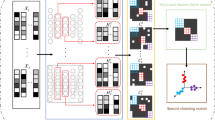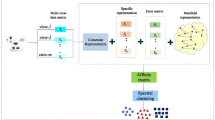Abstract
Since multi-view subspace clustering combines the advantages of deep learning to capture the nonlinear nature of data, deep multi-view subspace clustering methods have demonstrated superior ability to shallow multi-view subspace clustering methods. Most existing methods assume that sample reconstruction errors incurred by noise conform to the prior distribution of the corresponding norm, allowing for simplification of the problem and focus on designing specific regularization on self-representation matrices to exploit consistent and diverse information among different views. However, the noise distributions in different views are always very complex, and in practice the noise distributions do not necessarily conform to this hypothesis. Furthermore, the commonly used diversity regularization based on value-awareness to enhance diversity among different view representations is not sufficiently accurate. To alleviate the above deficiencies, we propose novel robust deep multi-view subspace clustering networks with a correntropy-induced metric (RDMSCNet). (1) A correntropy-induced metric (CIM) is utilized to flexibly handle various complex noise distributions in a data-driven manner to improve the robustness of the model. (2) A position-aware diversity regularization based on the exclusivity definition is employed to enforce the diversity of the different view representations for modelling the consistency and diversity simultaneously. Extensive experiments show that RDMSCNet can deliver enhanced performance over state-of-the-art approaches.








Similar content being viewed by others
References
Sun X, He Z, Zhang X, Zou W, Baciu G (2016) Saliency detection via diversity-induced multi-view matrix decomposition. In: Asian conference on computer vision, pp 137–151
Yao X, Han J, Zhang D, Nie F (2017) Revisiting co-saliency detection: a novel approach based on two-stage multi-view spectral rotation co-clustering. IEEE Trans Image Process 26(7):3196–3209
Zhang Q, Liu Y, Zhu S (2017) Salient object detection based on super-pixel clustering and unified low-rank representation. Comp Vision Image Underst 161:51–64
Liu G, Lin Z, Yong Y (2010) Robust subspace segmentation by low-rank representation. In: International conference on machine learning pp 663–670
Xia G, Sun H, Feng L, Zhang G, Liu Y (2017) Human motion segmentation via robust kernel sparse subspace clustering. IEEE Trans Image Process 27(1):135–150
Ji P, Zhong Y, Li H, Salzmann M (2014) Null space clustering with applications to motion segmentation and face clustering. In: IEEE International conference on image processing, pp 283–287
Tulsiani S, Efros A, Malik J (2018) Multi-view consistency as supervisory signal for learning shape and pose prediction. In: IEEE conference on computer vision and pattern recognition, pp 2897–2905
Wang X, Lei Z, Guo X, Zhang C, Shi H, Li SZ (2019) Multi-view subspace clustering with intactness-aware similarity. Pattern Recog 88:50–63
Cao X, Zhang C, Zhou C, Fu H, Foroosh H (2015) Constrained multi-view video face clustering. IEEE Transactions on Image Processing 24(11):4381–4393
Si X, Yin Q, Zhao X, Yao L (2022) Consistent and diverse multi-view subspace clustering with structure constraint. Pattern Recogn, 121:108196
Zhao J, Lyu G, Feng S (2021) Linear neighborhood reconstruction constrained latent subspace discovery for incomplete multi-view clustering. Applied Intelligence
Zhang GY, Chen XW, Zhou YR, Wang CD, Huang D, He XY (2021) Kernelized multi-view subspace clustering via auto-weighted graph learning. Applied Intelligence
Mi Y, Ren Z, Mukherjee M, Huang Y, Sun Q, Chen L (2021) Diversity and consistency embedding learning for multi-view subspace clustering. Applied Intelligence
Zhu W, Lu J, Zhou J (2019) Structured general and specific multi-view subspace clustering. Pattern Recog 93:392–403
Wang D, Yin Q, He R, Wang L, Tan T (2015) Multi-view Clustering via Structured Low-rank Representation. In: Proceedings of the 24th ACM international on conference on information and knowledge management, pp 1911–1914
Yin M, Liu W, Li M, Jin T, Ji R (2021) Cauchy loss induced block diagonal representation for robust multi-view subspace clustering. Neurocomputing 427:84–95
Yin Q, Wu S, He R, Wang L (2015) Multi-view clustering via pairwise sparse subspace representation. Neurocomputing 156:12–21
Elhamifar E, Vidal R (2009) Sparse subspace clustering. In: IEEE conference on computer vision and pattern recognition, pp 2790–2797
Lu C, Min H, Zhao Z, Zhu L, Huang D-S, Yan S (2012) Robust and efficient subspace segmentation via least squares regression. In: European c on computer vision, pp 347–360
Zhang C, Hu Q, Fu H, Zhu P, Cao X (2017) Latent multi-view subspace clustering. In: IEEE conference on computer vision and pattern recognition, pp 4279–4287
Cao X, Zhang C, Fu H, Liu S, Zhang H (2015) Diversity-induced multi-view subspace clustering. In: IEEE conference on computer vision and pattern recognition, pp 586–594
Gretton A, Bousquet O, Smola A, Schlkopf B (2005) Measuring statistical dependence with hilbert-schmidt norms. In: Algorithmic learning theory, 16th international conference, pp 63– 77
Luo S, Zhang C, Zhang W, Cao X (2018) Consistent and specific multi-view subspace clustering. In: AAAI conference on artificial intelligence, pp 3730–3737
Zhou T, Zhang C, Peng X, Bhaskar H, Yang J (2020) Dual shared-specific multiview subspace clustering. IEEE Transactions on Cybernetics 50(8):3517–3530
Li R, Zhang C, Fu H, Peng X, Zhou TJ, Hu Q (2016) Reciprocal multi-layer subspace learning for multi-view clustering. In: IEEE international conference on computer vision, pp 8171– 8179
Abavisani M, Patel VM (2018) Deep multimodal subspace clustering networks. IEEE Journal of Selected Topics in Signal Processing 12(6):1601–1614
Lu R, Liu J, Zuo X (2021) Attentive multi-view deep subspace clustering net. Neurocomputing 435:186–196
Zhu P, Hui B, Zhang C, Du D, Wen L, Hu Q (2019) Multi-view deep subspace clustering networks. arXiv
Chao G, Sun J, Lu J, Wang A, Langleben D, Li C, Bi J (2019) Multi-view cluster analysis with incomplete data to understand treatment effects. Inf Sci 494:278–293
Yin Q, Zhang J, Wu S, Li H (2019) Multi-view clustering via joint feature selection and partially constrained cluster label learning. Pattern Recog 93:380–391
Chao G, Sun S, Bi J (2021) A survey on multiview clustering. IEEE Trans Artif Intell 2 (2):146–168
Liu G, Lin Z, Yan S, Sun J, Yu Y, Ma Y (2013) Robust recovery of subspace structures by low-rank representation. IEEE Trans Pattern Anal Mach Intell 35(1):171–184
Xia R, Pan Y, Du L, Yin J (2014) Robust multi-view spectral clustering via low-rank and sparse decomposition. In: AAAI Conference on Artificial Intelligence, pp 2149–2155
Wang X, Guo X, Lei Z, Zhang C, Li S (2017) Exclusivity-consistency regularized multi-view subspace clustering. In: IEEE conference on computer vision and pattern recognition, pp 923–931
Li C, Vidal R (2015) Structured sparse subspace clustering: A unified optimization framework. In: IEEE conference on computer vision and pattern recognition, pp 277–286
Ng AY, Jordan MI, Weiss Y (2002) On spectral clustering: Analysis and an algorithm. Advances in Neural Information Processing Systems, pp 849–856
Ye X, Wang L, Xing H, Huang L (2015) Denoising hybrid noises in image with stacked autoencoder. In: IEEE international conference on information and automation, pp 2720–2724
Wei W, Yan H, Wang Y, Liang W (2014) Generalized autoencoder: A neural network framework for dimensionality reduction. In: Proceedings of the IEEE conference on computer vision and pattern recognition workshops, pp 490–497
Peng X, Xiao S, Feng J, Yuan W, Yi Z (2016) Deep subspace clustering with sparsity prior. In: Proceedings of the twenty-fifth international joint conference on artificial intelligence, pp 1925–1931
Ji P, Zhang T, Li H, Salzmann M, Reid I (2017) Deep subspace clustering networks. In: NIPS conference on neural information processing systems, pp 23–32
Peng X, Feng J, Zhou JT, Lei Y, Yan S (2020) Deep subspace clustering. IEEE Trans Neural Netw Learn Syst 31(12):5509–5521
Elhamifar E, Vidal R (2013) Sparse subspace clustering: Algorithm, theory, and applications. IEEE Trans Pattern Anal Mach Intell 35(11):2765–2781
Huang Q, Zhang Y, Peng H, Dan T, Cai H (2020) Deep subspace clustering to achieve jointly latent feature extraction and discriminative learning. Neurocomputing 404:340–350
Guo X (2016) Exclusivity regularized machine. arXiv:1603.08318
Liu W, Pokharel PP, Principe JC (2007) Correntropy: Properties and applications in non-gaussian signal processing. IEEE Trans Sign Process 55(11):5286–5298
Chen B, Xing L, Zhao H, Zheng N, Prncipe JC (2016) Generalized correntropy for robust adaptive filtering. IEEE Trans Sign Process 64(13):3376–3387
Ma W, Qu H, Gui G, Xu L, Zhao J, Chen B (2015) Maximum correntropy criterion based sparse adaptive filtering algorithms for robust channel estimation under non-gaussian environments. J Frankl Inst 352(7):2708–2727
Do B, Wang Z, Zhang L, Tao D (2017) Robust and discriminative labeling for multi-label active learning based on maximum correntropy criterion. IEEE Trans Image Process 26(4):1694–1707
Xu G, Du S, Xue J (2016) Precise 2d point set registration using iterative closest algorithm and correntropy. In: Proceedings of the International Joint Conference on Neural Networks, pp 4627–4631
Cao Z, Principe JC, Ouyang B (2016) Information point set registration for shape recognition. In: IEEE international conference on acoustics, pp 2603–2607
Kou Q, Cheng D, Chen L, Zhao K (2018) A multiresolution gray-scale and rotation invariant descriptor for texture classification. IEEE Access 6:30691–30701
Lades M, Vorbruggen JC, Buhmann J, Lange J, Von Der Malsburg C, Wurtz RP, Konen W (1993) Distortion invariant object recognition in the dynamic link architecture. IEEE Trans Comput 42(3):300–311
Weng W, Zhou W, Chen J, Peng H, Cai H (2020) Enhancing multi-view clustering through common subspace integration by considering both global similarities and local structures. Neurocomputing 378:375–386
Jiang Y, Yang Z, Xu Q, Cao X, Huang Q (2018) When to learn what: Deep cognitive subspace clustering. In: Proceedings of the 26th ACM international conference on multimedia, pp 718–726
Acknowledgements
This study was funded by the Key Program of National Natural Science Foundation of China (grant no. 61731003) and the Funds for National Natural Science Foundation of China (grant no. 61871040).
Author information
Authors and Affiliations
Corresponding author
Additional information
Publisher’s note
Springer Nature remains neutral with regard to jurisdictional claims in published maps and institutional affiliations.
This article belongs to the Topical Collection: Special Issue on Multi-view Learning
Guest Editors: Guoqing Chao, Xingquan Zhu, Weiping Ding, Jinbo Bi and Shiliang Sun
Rights and permissions
About this article
Cite this article
Si, X., Yin, Q., Zhao, X. et al. Robust deep multi-view subspace clustering networks with a correntropy-induced metric. Appl Intell 52, 14871–14887 (2022). https://doi.org/10.1007/s10489-022-03209-9
Accepted:
Published:
Issue Date:
DOI: https://doi.org/10.1007/s10489-022-03209-9




